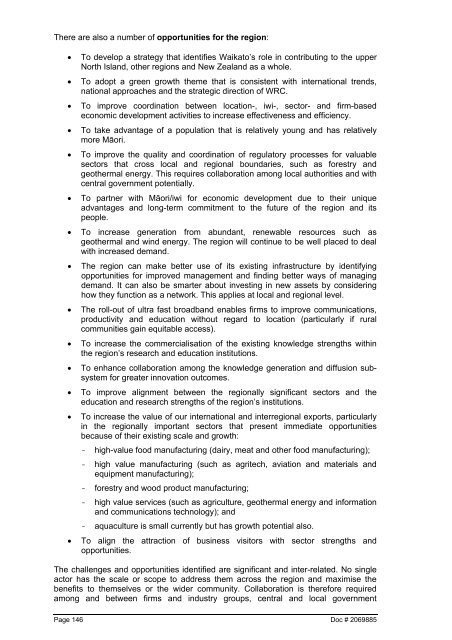Waikato regional economic profile - Waikato Regional Council
Waikato regional economic profile - Waikato Regional Council
Waikato regional economic profile - Waikato Regional Council
- No tags were found...
You also want an ePaper? Increase the reach of your titles
YUMPU automatically turns print PDFs into web optimized ePapers that Google loves.
There are also a number of opportunities for the region:To develop a strategy that identifies <strong>Waikato</strong>’s role in contributing to the upperNorth Island, other regions and New Zealand as a whole. To adopt a green growth theme that is consistent with international trends,national approaches and the strategic direction of WRC.To improve coordination between location-, iwi-, sector- and firm-based<strong>economic</strong> development activities to increase effectiveness and efficiency. To take advantage of a population that is relatively young and has relativelymore Māori. To improve the quality and coordination of regulatory processes for valuablesectors that cross local and <strong>regional</strong> boundaries, such as forestry andgeothermal energy. This requires collaboration among local authorities and withcentral government potentially. To partner with Māori/iwi for <strong>economic</strong> development due to their uniqueadvantages and long-term commitment to the future of the region and itspeople.To increase generation from abundant, renewable resources such asgeothermal and wind energy. The region will continue to be well placed to dealwith increased demand. The region can make better use of its existing infrastructure by identifyingopportunities for improved management and finding better ways of managingdemand. It can also be smarter about investing in new assets by consideringhow they function as a network. This applies at local and <strong>regional</strong> level. The roll-out of ultra fast broadband enables firms to improve communications,productivity and education without regard to location (particularly if ruralcommunities gain equitable access). To increase the commercialisation of the existing knowledge strengths withinthe region’s research and education institutions. To enhance collaboration among the knowledge generation and diffusion subsystemfor greater innovation outcomes. To improve alignment between the <strong>regional</strong>ly significant sectors and theeducation and research strengths of the region’s institutions.To increase the value of our international and inter<strong>regional</strong> exports, particularlyin the <strong>regional</strong>ly important sectors that present immediate opportunitiesbecause of their existing scale and growth:- high-value food manufacturing (dairy, meat and other food manufacturing);- high value manufacturing (such as agritech, aviation and materials andequipment manufacturing);- forestry and wood product manufacturing;- high value services (such as agriculture, geothermal energy and informationand communications technology); and- aquaculture is small currently but has growth potential also.To align the attraction of business visitors with sector strengths andopportunities.The challenges and opportunities identified are significant and inter-related. No singleactor has the scale or scope to address them across the region and maximise thebenefits to themselves or the wider community. Collaboration is therefore requiredamong and between firms and industry groups, central and local governmentPage 146 Doc # 2069885
















